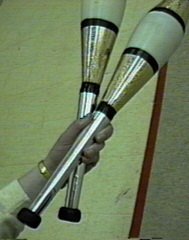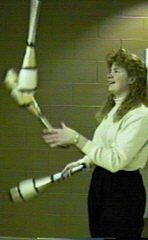
Many jugglers consider clubs their favorite props, and club passing is one of the most popular activities at juggling clubs and festivals. The flipping motion of clubs makes them more difficult to juggle than balls, but that's also what makes them look so cool in motion, and it gives you new possibilities for tricks. Learning to juggle 3 clubs doesn't take long at all once you can comfortably juggle 3 balls. These instructions will help you get started.
If you don't have a juggling shop nearby, call a prop manufacturer or dealer and ask for a catalog. Brian Dube, Todd Smith and Renegade make some of the most popular clubs in America. You can find their products and others at Serious Juggling.
This is matter of regular debate on the newsgroup rec.juggling. Most jugglers will agree however, that if you're serious about juggling, you should buy good clubs right away. Any club made by the companies listed above will be well made, well balanced and long lasting. Most jugglers prefer a European style club for recreational juggling. The European style club is fairly slim, has a hardwood dowel in the center, and a flexible handle that cushions the impact on your hands. They usually have padded knobs and ends to absorb the shock when they hit the floor. They are available with a wide variety of decorations and look very flashy, though the slender shape makes them less visible to audiences. This is the main reason some performers prefer American style clubs. An American club is a fatter, one-piece molded plastic club. Some have padded ends and they're available decorated and plain.
It's also possible to make clubs from old newspapers, tightly wrapped together. You can find detailed instructions here.
Here's the bottom line: If you can afford a set of European clubs, get them. If the price is a bit much, try the newspaper clubs, or buy a seet of decent one-piece club, like a Dube Airflite. They're reasonably priced, durable, and balanced very much like European clubs.
You'll go through the same steps as you did learning to juggle 3 balls:

Hold one club in your hand, gripping the middle of the handle, with your thumb pointing towards the body of the club. Many beginners make the mistake of holding the clubs very near the knob, giving them less control over the flip. Lower your arm till the club is pointing at the floor and aimed out to the side a bit. Next, bring it up and throw it to a height a foot or so above the top of your head. As you bring the club up to throw it, tilt it inward, angling towards you other hand. Catch the club after one flip, when it's level with the handle pointing at you. Try to throw the club so that it makes one flip by the time it falls back to the height of your hand. If it's not flipping fast enough, you can throw it heigher to give it more time to flip, or flip it faster. To put a faster flip on the club push down with your thumb and up with your fingers as your release it. Practice throwing one club from hand to hand until you're make consistent one-flip throws and catches.
Hold a club in each hand. Throw one from your right hand to your left, and throw the other from left to right when the first club peaks. Catch the first club in your left hand, then the second in your right. Just like you did when you were learning 3 balls, make sure you make both throws to the same height, and watch the peaks of the throws. Practice it the other way too, with your left hand throwing first. Keep practicing until you're catching both clubs with a single flip consistently.
Ok, so we'll skip a step from learning 3 balls (the "flash".) Hold two clubs in one hand as shown, and one club in the other hand.

The top club in the illustration will be thrown first. It may take a few tries to get the hang of throwing that first club with a clean single flip. You know what to do next: when that club peaks, throw the next and so on. Pay attention to the amount of flip you're putting on each throw. If you're having trouble, try adding a little more flip and lowering the pattern a bit. It will take some practice, but soon you'll be juggling three clubs.

Catching two clubs in one hand is a little trickier than catching two balls in one hand. You can learn to do it with practice. Catch the first club the usual way, then extend your thumb, index and middle finger. Point the club to the outside of the pattern a bit, and catch the second club on top of the first, gripping it with your thumb, index and middle fingers. The drawback of this method is that you'll probably smash the tips of your ring and little fingers between the two clubs a few times before you master it.
Another method of collecting three clubs, and perhaps the most popular, is to make the last throw extra high, usually with a double flip. That high throw gives you some extra time. Once you've caught a club in each hand, hand one off from one hand to the other. That leaves you an empty hand to catch the high throw. It looks flashier than catching two in one hand, and is less likely to hurt your hands.
Once you can start, juggle and collect three clubs, it's time to try some tricks. A great trick to start with is a double flip. Remember that you can throw a double either by throwing higher or flipping the club faster, pressing down with your thumb and up with your fingers as you release the club. Try it both ways, and work your way up to doing continuous double throws. Try a high double straight up, so it will come back to the hand that threw it. When it peaks, make a crossing throw from the same hand and resume the cascade. Then what the heck... try some triples. Then do something with all the time that high throw gives you. A pirouette is a great move to add to a high throw.
Other good tricks to start with include under the leg, and "flats", throws with no flip at all. Backcrosses (behind the back throws) are very popular with clubs. They requires more practice than most club tricks, especially to master continuous backcrosses. Try each trick a few times with only one club, then try it in the cascade.
From time to time you'll catch a club by the wrong end, especially when you're doing tricks. Practice catching a club that way and throwing it with either a half flip or a flip in a half to get it back to the right end. Before long it will become habit to correct half flips immediately without missing a beat.